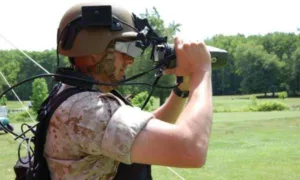The ONR (Office of Naval Research) as part of the US Navy has been working on an augmented reality training headset for years and now they have shown the results of their work at an event in Quantico, VA.
The AITT (Augmented Immersive Team Training) program that “is an augmented reality training system that integrates with the US Marine Corps’ ground combat team training instrumentation system, Instrumented Tactical Engagement Simulation System (ITESS II) to display virtual indirect fire effects, aircraft, vehicles, and/or role players onto actual terrain”. As this system is for training purposes only, the development is a little more transparent than the development of gear developed for use in the theater.
While the ONR does not say who actually manufactured the headset, it is known that Lockheed Martin is part of the development team and responsible for providing the rendering software technology that overlays the virtual entities onto the live video scene, while making it look as real as possible.
Source: phys.org
The headset does not even remotely look like Google Glass or similar headsets – it is not especially fashionable or extra small. However, the goal is to provide a realistic environment to the training personnel, not a headset for a trip around town.
The demonstration did show a realistic battlefield environment overlayed on a golf course at Quantico. While some were looking at a sand trap as just a hazard on the golf course, the training personnel saw explosions, landing aircraft and the likes. Normally training commences on a training range, where certain realities are created to allow new personnel to train under controlled conditions. In terms of military training, pre-set conditions are typically the norm, leaving further training to the real situation in the field. The AITT aims at adding a new level of training that is more realistic than a training range.
The real challenge for the program is to see how real their training environments can really become. The trainee knows that the scenario is not real, but has to rely on vision and sound to create the feel of a real situation. Unsurprisingly, the program challenges are seen mostly in providing adequate fidelity of a lifelike situation to replace some live training resources. The team also wonders if commercial AR headsets could create the required field of vision, resolution, weight and brightness to replace their developed headset in the field. – NH

